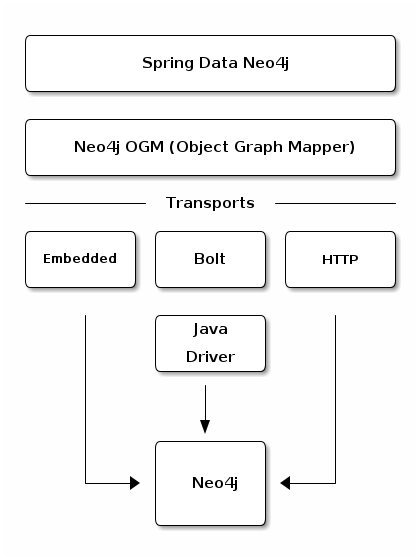This article introduces the main building blocks you need to understand when dealing with Spring Data Neo4j and Neo4j-OGM. It applies regardless whether you’re on a Spring Boot application or a plain Spring application.
1. Problem
The problem comes in different flavors:
-
How is OGM and its components related to SDN?
-
I went to start.spring.io, created a Spring Boot application and all I got was this starter
spring-boot-starter-data-neo4j. What does it do? -
Which dependencies do I need to make Spring Data Neo4j work in a plain, old Spring application?
-
Which versions fit together?
2. Answer
2.1. The relation between SDN, OGM and transports
From a high level architecture overview, things look like this

- Spring Data Neo4j
-
Spring Data Neo4j is one of several different store implementations of Spring Data. Spring Data’s mission is to provide a familiar and consistent, Spring-based programming model for data access while still retaining the special traits of the underlying data store.
- Neo4j OGM
-
Neo4j OGM is an Object Graph Mapper. It maps the nodes, relationships and properties stored inside Neo4j to Java objects. It acts on the same architectural level as Hibernate does for relational databases. Neo4j generates Cypher queries to read and write your Graph data (at least, most of the time). Your domain classes lives at this layer. You’ll find classes annoted with
@NodeEntityfor things that have an ID and a live cycle and@QueryResultfor data transfer objects (DTOs) and projections. Everything inside OGM happens in transactions. - Transports
-
The next lower level is a transport layer. Neo4j OGM can use different transports. Sometimes Neo4j-OGM will speak of them as drivers but that is not totally accurate.
-
Embedded: Uses an embedded Neo4j instance, OGM transport mainly uses the internal Database Api
-
Bolt: This transport actually uses a real driver, the Neo4j Java Driver. The Java Driver works pretty much on the same level as JDBC.
-
HTTP: The HTTP transport was the first to be available. Neo4j OGM uses Neo4j’s REST endpoints.
-
2.2. Spring Boot
If you go to start.spring.io and generate a Neo4j Project (use this link to get one), you’ll end up with the following dependencies
-
Spring Data Commons
-
Spring Data Neo4j
-
Neo4j OGM (Core)
-
Neo4j Bolt
-
Neo4j Java Driver
This is a setup which expects you to have a local instance of Neo4j listening on port 7687 for Bolt connections.
The connection can be configured through spring.data.neo4j.uri.
The dependencies are configured in such way that you can bring in the additional embedded driver and the embedded Neo4j instance without running into conflicts:
<dependency>
<groupId>org.neo4j</groupId>
<artifactId>neo4j-ogm-embedded-driver</artifactId>
<version>${neo4j-ogm.version}</version> (1)
</dependency>
<dependency>
<groupId>org.neo4j</groupId>
<artifactId>neo4j</artifactId>
<version>3.4.5</version>
<scope>runtime</scope> (2)
</dependency>| 1 | Use the same version that Spring Boot uses for OGM itself |
| 2 | The database itself is only needed during runtime |
There’s one catch, though: If the embedded driver is on the classpath, Spring Data Neo4j autoconfiguration will prefer it over Bolt.
You can disable this by spring.data.neo4j.embedded.enabled=false or by using it only inside the test scope.
This comes in pretty handy if you use the @DataNeo4jTest test slice that is new with Spring Boot 2.
It will automatically use the embedded instance for executing your tests against the database inside transactions that are rolled back after the tests.
2.3. And without Spring Boot?
We highly recommend to start new Spring application based on Spring Boot. In contrast what you might have heard, Spring Boot is not only about microservices.
However, there are situations where you find yourself in a plain Spring situation. You’ll need at last:
-
org.springframework.data:spring-data-neo4j -
org.neo4j:neo4j-ogm-core -
A matching transport, like
-
org.neo4j:neo4j-ogm-bolt-driver -
org.neo4j:neo4j-ogm-embedded-driver
-
They all bring their necessary, transitive dependencies. You have to make sure though that they fit into their surroundings. That is, you cannot run any Spring Data release train after "Kay" (corresponds to Spring Data Neo4j 5.0.x) with Spring 4 or earlier.
2.4. Which versions fit together?
From the Spring Data commons documentation:
Spring Data is an umbrella project consisting of independent projects with, in principle, different release cadences. To manage the portfolio, a BOM (Bill of Materials - see this example) is published with a curated set of dependencies on the individual project. The release trains have names, not versions, to avoid confusion with the sub-projects.
As of today Spring Data Neo4j 5.0.x and 5.1.x are under active development. That means:
As of writing, Spring Boot 2.0.x picks up the Kay release train but OGM 3.1.x.
In case this causes any trouble in edge cases, add <neo4j-ogm.version>3.0.4</neo4j-ogm.version> to your POM or neo4j-ogm.version=3.0.4 to gradle.properties.
Both Kay and Lovelace requires Spring 5 and therefore Spring Boot 2.
For Spring Boot 1.5.x you’ll have to use the Ingalls release train, referring to SDN 4.2.x and OGM 2.1.x. To connect to older versions of Neo4j (2.3, 3.0 and 3.1), you have to stick with OGM 2.1.x and therefore with SDN 4.2.x as well.
OGM 3.x supports Neo4j 3.x.
2.5. Further reading
-
Gerrit’s presentation about SDN and OGM at Spring I/O 2018: Video recording and Slides
-
Checkout the type conversions that may be applied by the Java driver Understand the Neo4j Cypher and OGM type system
-
About the Kay release train
-
Announcing the first release candidate of Spring Data Lovelace